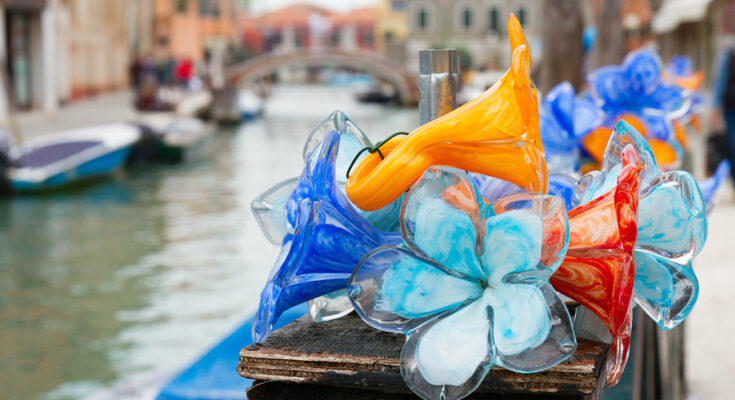Well-known for its canalside charm and for being close to Venice but less touristy and more real, Murano Island is a very special place in its own right. It is more than just a quaint set of small islands next to Venice but is itself a big tourist destination thanks to its world-famous glassware.
What Is So Special About Murano, Italy
A typical Murano Glass factory and furnace in Murano, Italy
When tourists come to Murano, they often search for a factory or a workshop where they can see a glass-blowing demonstration. While many commercial enterprises prey on unsuspecting tourists with quick unprofessional demos and a subsequent tour of the “showroom”, demonstrations by real Murano artisans are very rare. Experienced glass masters do not want to be disturbed by tourist crowds, so most factories are closed to visitors. But this does not mean that you cannot learn about Murano glass-making. In this article, we will explain all about the special craftsmanship, the unique features, and the reasons you should own a piece of Murano’s long glass-blowing tradition.
The Brief Story Of Murano Glass
Murano Glass is a timeless treasure that has fascinated people around the world for centuries. From the bright colors of Murano Glass jewelry to the vibrant designs of Murano Glass vases, the craftsmanship of these pieces is mindblowing. It is a result of carefully passing glassmaking secrets through generations of masters. But what makes Murano Glass so sought after, so universally cherished? The answer lies in its compelling history, its stunning beauty, and the painstaking process behind each unique creation.
Murano Glass has earned its global popularity mainly thanks to its rich heritage. It originally came from the Roman Empire where merchants traveled far and wide and knowledge exchange helped propel a thriving economy and culture. Eventually, Rome fell and barbarian invasions became a regular occurrence. People were fleeing barbarian-captured territories trying to settle in places that were hardest to conquer, typically on the islands or in the mountains.
Venice became just such a refuge. Many skilled artisans settled there and some of them were talented glassblowers who set up furnaces to make practical glass pieces. These items were in demand and the craft thrived. Once Venice became a densely populated and wealthy city, the Venetian authorities decided to move the glass-making industry to Murano Island in the 13th century.
Artisans have been working in Murano ever since. There was never any formal training for this craft, artisans simply passed down their knowledge and techniques through generations, preserving ancient art and continually refining it. This imbues each piece of Murano Glass with a narrative that is rooted in culture and tradition – a quality that attracts many collectors to this art form.
Why Murano Glass Is So Beautiful
The allure of Murano Glass is not just in its history, but also in its spectacular beauty. The striking vibrancy of the hues, the meticulously crafted shapes, and the interplay of light make each piece a visual delight. Murano Glass jewelry captures the beauty of the Venetian lagoon’s sunsets and the sparkling waters in small, wearable works of art. Venetian earrings, rings, and pendants shine with a light that seems to radiate from within, reflecting the artisan’s mastery of color blending and temperature control. These qualities are even more evident in art glass pieces, such as the renowned Murano Glass vases. Each vase is a testament to the innovative spirit of the artist, flaunting designs that range from exquisitely elegant to boldly abstract.
How Murano Glass Is Made
Creating a Murano Glass Sculpture in a factory in Murano, Italy
One of the cornerstones of Murano Glass’ appeal is fine craftsmanship and the complex techniques involved in its creation. A single piece may take hours to complete by multiple artisans working in tandem. Other pieces such as larger artworks or chandeliers may take days or even weeks. Even though this process is very tough and labor-intensive, the resulting glass creations look effortlessly beautiful, with a harmony that characterizes masterpieces. The techniques the artisans use are part of a time-honored tradition passed down through generations.
The “murrina” or “millefiori” technique, for instance, involves the creation of intricate patterns by heating glass rods of various colors, fusing them, and then slicing them to reveal a mosaic pattern on the cross-section. The “sommerso” technique, on the other hand, involves submerging a colored glass piece into another molten glass layer, creating an illusion of floating colors. The “avventurina” technique allows embedding tiny copper particles in the glass to give it a shimmery effect. These painstaking processes result in a richness of colors, patterns, and captivating aesthetics, making each Murano Glass piece unique and valuable. Whether it’s a piece of jewelry or a decorative vase, the craftsmanship adds substantial value to the final product, making it a cherished possession.
All this glass-making magic happens in Murano Glass factories and workshops known in Italian as ‘fornaci’ spread throughout the multiple small islands that make up Murano, Italy. Working in those workshops Murano masters have polished their skills, taught the apprentices, and sustained the enduring tradition of Murano Glass making. These very basic and even rough environments hum with the heat of the furnaces and bustle with the highly coordinated activities of the artisans. Amid the glowing fires inside each furnace, the maestri (masters) manipulate molten glass into elegant forms, while apprentices observe and assist, gradually gaining hands-on experience. This unstructured yet highly effective form of learning ensures that the ancient knowledge and unique skills persist through generations, creating a lineage of craftsmanship unparalleled elsewhere.
Modern Challenges to Murano Glass Industry
While this incredible tradition continues to thrive, the art of Murano Glass is facing some modern-day challenges. The appeal of a life beyond the Venetian islands and the lure of better-paying jobs have caused a decline in the number of young people willing to endure the many years of apprenticeship necessary to master this craft. Despite these challenges, efforts are being made to preserve this precious heritage. Artisans, local bodies, and international organizations are collaborating to ensure
When considering the purchase of a Murano Glass item, there are a few key considerations to bear in mind. Authenticity is paramount – genuine Murano Glass is handmade only on the island of Murano using traditional methods. Certification of authenticity or proof of origin is a crucial indicator of a genuine piece. Additionally, the price reflects the complexity of the design and the labor involved; therefore, it can vary substantially. Buyers should also note the difference in quality and craftsmanship – the brilliance of colors, the precision of patterns, and the overall design aesthetics reflect the expertise of the artisan.
Why Collect Murano Glass?
Murano Glass vases and sculptures in a shop window in Murano, Italy
The popularity of Murano Glass stems from its rich historical narrative, its breathtaking beauty, and the remarkable craftsmanship behind each piece. These elements, combined with the pleasure of owning or wearing an artwork steeped in tradition, make Murano Glass an irresistible choice for many. Whether you start from just one inherited item or from a piece you bought in Venice, you will likely want to expand your collection. Whether it’s a stunning Murano Glass vase enriching the aesthetics of a home, or a piece of jewelry adding a dash of Venetian glamour, the charm of Murano Glass continues to enchant people worldwide, sustaining its timeless appeal.




